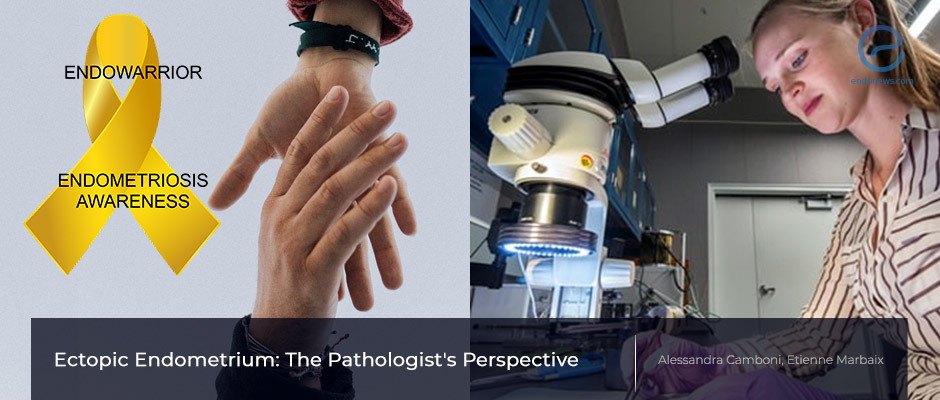A plea from pathologists: standardized protocols for adenomyosis and endometriosis
Dec 20, 2021
There is a need for standardized ectopic endometrial tissue reporting in pathology specimens
Key Points
Highlights:
- Endometriosis and adenomyosis are closely related entities defined as the existence of displaced (ectopic) endometrial tissues in myometrium and extra-uterine places, respectively.
- Many early 20th-century pathology scholars put forward several views on ectopic endometrial tissues but only Sampson offered the still widely accepted theory of “retrograde menstruation” in 1920.
- Despite recent developments, the etiopathogenesis of these entities still remains unclear, since there are no standardized pathological diagnostic criteria and reporting systems in medical practice it is hard to analyze and classify these disorders.
Importance:
- Ectopic endometrial tissues, adenomyosis, and endometriosis affect many reproductive-age women causing clinical presentations related to pelvic pain and infertility.
- Although transvaginal ultrasound and magnetic resonance imaging [MRI], has achieved major progress in the diagnostic workup, the gold standard in the diagnosis of adenomyosis and endometriosis is still pathologic examination of surgical tissue biopsies.
What's done here
- This is a review summarizing current knowledge on ectopic endometria, i.e. adenomyosis and endometriosis, emphasizing the pathologic aspects related to clinical medicine.
- Historical and histopathological features of adenomyosis and endometriosis, their risk for malignant transformation, as well as current knowledge on their etiopathogenesis are presented.
- As diagnostic surgical pathologists, the authors comment on the necessity for standardized pathology reporting protocols.
Key results
- Despite recent scientific progress, etiopathogenetic mechanisms of adenomyosis and endometriosis have not been precisely revealed yet.
- New scientific research topics in pathology should be vitalized in order to develop standardized classifications describing and reporting adenomyosis and endometriosis to avoid clinical misunderstandings.
- There is a need for comprehensive and widely accepted pathologic classifications yielding further insight into these enigmatic diseases. This is of utmost importance in yielding better quality of life and effective treatment for patients searching for a cure.
Lay Summary
Pathologist Drs. Camboni and Marbaix from Brussels, Belgium published their comprehensive review on adenomyosis and endometriosis titled “Ectopic endometrium: the pathologists’ perspective” in a recent issue of the International Journal of Molecular Sciences.
Endometriosis and adenomyosis are well-known entities as the existence of ectopic endometrial tissues in myometrium and extra-uterine places respectively. As early as the beginning of the 20th century, world-renowned pathologists Rokitansky, Meyer, Cullen, and Frankl put forward views on ectopic endometrial tissues. However, only Sampson put forward the still widely accepted theory of “retrograde menstruation” in 1920. Our contemporary understanding of adenomyosis mostly emerged relatively late, in 1972, Bird and associates defined this ailment as a “benign invasion of the endometrium into the myometrium” at that time.
At the histopathological examination, adenomyosis and endometriosis look similar since the main feature in both is the presence of normal endometrial tissue composed of glandular epithelium and stroma outside the uterine cavity. However, they differ in clinical presentations mainly due to their different localizations.
The main diagnostic problem in adenomyosis resides in being different methods of assessing glandular depth of invasion from the basalis some using an absolute measurement and others a percentage. Most importantly, the pathological diagnosis of adenomyosis depends on tissue sampling procedures and irregularity of the endometrial-myometrial interface. On the other hand, pathologic diagnosis of endometriosis may be troublesome in cases where the glandular or stromal compartment is altered or absent, in case of small amounts of sampling, or when unusual sites being involved Also in cases showing features occasionally resembling neoplastic tissues such as pseudo-xanthomatous changes, vascular, lymphatic and perineural infiltration that may mislead the inexperienced pathologists.
At the time being, none of the previously proposed pathological classification systems in endometriotic tissues are not widely accepted or implemented. The lack of a consensus well-organized classification system is a concern in the clinical management of endometriosis also.
There is a solid need for comprehensive and widely accepted pathologic classifications yielding further insight into these enigmatic diseases. Research regarding this dilemma in pathology should be encouraged in order to develop standardized well-accepted classifications describing and reporting adenomyosis and endometriosis in order to reach better clinical management.
Research Source: https://pubmed.ncbi.nlm.nih.gov/34681634/
ectopic endometrium adenomyosis endometriosis pathology pathology protocols pathologists surgical pathology

